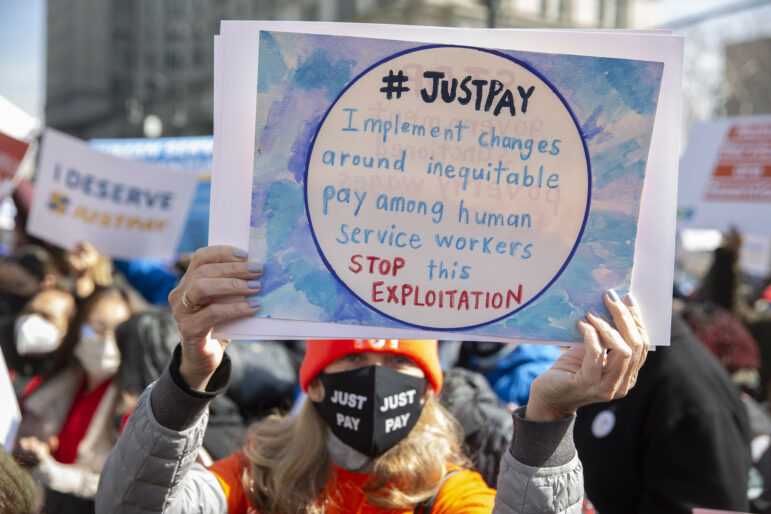Immigrant-headed households make up only 17 percent of the city’s population but constitute 21 percent of households earning below the “true cost of living.”

John McCarten/NYC Council Media Unit
A rally calling for higher wages in 2022.Lea la versión en español aquí.
Around 64 percent of immigrants in New York City don’t make enough to meet their basic needs, according to a report released Tuesday.
Half of all New Yorkers’ salaries are too low to cover the costs of rent, child care, food, health care, transportation, taxes, and other basic needs. Those together make up the “true cost of living” (formerly known as the Self-Sufficiency Standard for New York City) used as the basis for the report, “Overlooked & Undercounted,” published by United Way of New York City and the Fund for the City of New York.
Despite making up only 17 percent of the population, the city’s 433,451 immigrant-headed households constitute 21 percent of households earning below the true cost of living rate.
Looking at country of origin, 73 percent of Mexican immigrant households do not have enough to make ends meet, followed by Dominican- and Central-American-led households, at 71 percent and 68 percent, respectively. The report found that 52 percent of the city’s naturalized citizens don’t earn enough to get by, compared to 30 percent of white U.S.-born citizens.
The report, which looked at data for the working-age population, found that 65 percent of Latino households struggle to afford living costs, followed by 58 percent of Black households and 51 percent of Asian, Native Hawaiian, or Pacific Islander New Yorkers.
The last time a report on the “true cost of living” was published was 2021, making this year’s report the first to properly measure the pandemic’s impact.
However, this year’s report does not include information about the more than 50,000 immigrants and asylum seekers who have come to New York City after crossing the U.S. border since last spring.
“These numbers would drastically change,” United Way President and CEO Grace Bonilla said.
The economic situation is more complicated for asylum seekers, who are navigating a clogged immigration court system and have a one-year deadline to file their cases. “For them, It is a race against time,” Bonilla said. “They can pursue legal status, but the window is closing every day.”
According to the report, 276,184 of the city’s immigrant households are considered “linguistically isolated”—in which no household members over the age of 14 speak English well—and almost three-quarters struggled economically. “61 percent of Spanish-speaking households struggle to make ends meet, but if they are linguistically isolated, their income inadequacy rate increased to 80 percent,” reads the report.
For Asian or Pacific Islander households, 72 percent don’t make enough if they are linguistically isolated, compared with 41 percent if they are not. Three-quarters of Bangladeshi-led households can’t keep up with the cost of basic needs, followed by 63 percent of Pakistani households, the report found.
New York’s single mothers were among the demographics to see the highest rate of income inadequacy, at 80 percent; among Latina single mothers, the rate jumps to 87 percent. In contrast, 69 percent of single-father households have inadequate income and 76 percent of Latino single fathers.
Programs like Promise NYC, through which the city subsidizes child care for 600 undocumented families, have been a game-changer for undocumented families who don’t qualify for other types of government aid.
“That’s why we need more of these programs. It’s preventive,” said Bonilla. “Having universal lunch and breakfast, while most of these families are working; making this information available in Spanish, is a huge part of this; and asking them what they need.”
Another component analyzed in the report was the correlation between income and educational attainment, and once again racial/ethnic disparities abound: In addition to the well-known gender gap in which women earn less than men at all levels of education, households of color tend to have higher income inadequacy rates at each educational level.
Moreover, communities of color must work more to achieve the same levels of economic sufficiency as white workers, the report found.








